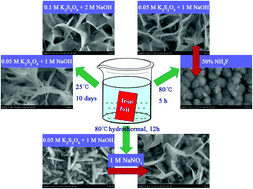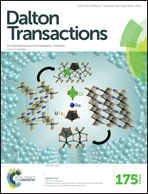A nanostructured hematite film prepared by a facile “top down” method for application in photoelectrochemistry
Abstract
To overcome tough conditions currently used for the preparation of nanostructured hematite films on a conducting substrate, a rational and easy method of chemical etching involving Fe3+ release and material growth in the presence of OH− has been developed. By carefully tuning the parameters influencing the morphologies of hematite, including the synthetic procedure, the concentration of etching solution, temperature, etching time and the morphology controlling surfactant, hematite films grown on iron foil with various morphologies (e.g. nanorod, nanowire, ultrathin nanoflake and cauliflower-like shape) have been achieved. In particular, it is found that F− is an effective surfactant to control the morphology as well as the crystallization process of hematite. Ultrathin nanoflakes having a minimized feature size exhibit the best photocurrent of 0.5 mA cm−2 (1.23 V vs. RHE, RHE is reversible hydrogen electrode) among the samples tested as a result of facilitated hole diffusion to the electrolyte and thus lowered carrier recombination. Compared with pristine hematite, a nearly tripled photocurrent is observed when H2O2 is added in the electrolyte as a hole scavenger, suggesting the presence of a charge injection barrier in the surface of samples. According to this, the strategy of Co2+ treatment is utilized and the improved photocurrent is seen, likely due to the improved water oxidation kinetics and surface state passivation. We believe that this convenient and economical method can be extended to the synthesis of other alkaline metal oxide nanomaterials as long as the redox potential of S2O82−/SO42− is higher than Mn+/M (M refers to metal).


 Please wait while we load your content...
Please wait while we load your content...